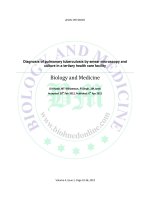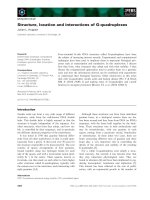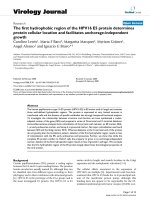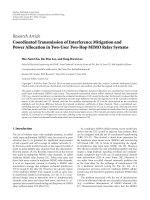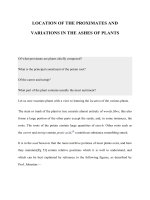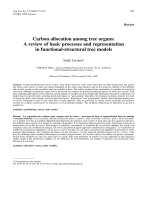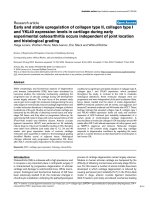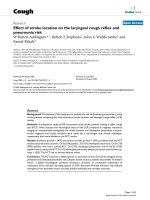Logistics of facility location and allocation
Bạn đang xem bản rút gọn của tài liệu. Xem và tải ngay bản đầy đủ của tài liệu tại đây (14.29 MB, 473 trang )
Tai Lieu Chat Luong
L O G I S T I C S O F
F A C I L I T Y L O C A T I O N
A N D A L L O C A T I O N
INDUSTRIAL ENGINEERING
A Series of Reference Books and Textbooks
1. Optimization Algorithms for Networks and Graphs, Edward Minieka
2. Operations Research Support Methodology, edited by Albert G.
Holzman
3. MOST Work Measurement Systems, Kjell B. Zandin
4. Optimization of Systems Reliability, Frank A. Tillman, Ching-Lai
Hwang, and Way Kuo
5. Managing WorkInProcess Inventory, Kenneth Kivenko
6. Mathematical Programming for Operations Researchers and Com
puter Scientists, edited by Albert G. Holzman
7. Practical Quality Management in the Chemical Process Industry,
Morion E. Bader
8. Quality Assurance in Research and Development, George W.
Roberts
9. ComputerAided Facilities Planning, H. Lee Hales
10. Quality Control, Reliability, and Engineering Design, BalbirS. Dhillon
11. Engineering Maintenance Management, Benjamin W. Niebel
12. Manufacturing Planning: Key to Improving Industrial Productivity,
Kelvin F. Cross
13. MicrocomputerAided Maintenance Management, Kishan Bagadia
14. Integrating Productivity and Quality Management, Johnson Aimie
Edosomwan
15. Materials Handling, Robert M. Eastman
16. InProcess Quality Control for Manufacturing, William E. Barkman
17. MOST Work Measurement Systems: Second Edition, Revised and
Expanded, Kjell B. Zandin
18. Engineering Maintenance Management: Second Edition, Revised and
Expanded, Benjamin W. Niebel
19. Integrating Productivity and Quality Management: Second Edition, Re
vised and Expanded, Johnson Aimie Edosomwan
20. Mathematical Programming for Industrial Engineers, edited by Mordecai Avriel and Boaz Go/any
21. Logistics of Facility Location and Allocation, D/7eep R. Sule
L O G I S T I C S O F
F A C I L I T Y L O C A T I O N
A N D A L L O C A T I O N
D I L E E P R . S U L
Louisiana Tech University
Ruston, Louisiana
MARCEL DEKKER, INC.
NEW YORK • BASEL
ISBN: 0824704932
This book is printed on acidfree paper.
Headquarters
Marcel Dekker, Inc.
270 Madison Avenue, New York, NY 10016
tel: 2126969000; fax: 2126854540
Eastern Hemisphere Distribution
Marcel Dekker AG
Hutgasse 4, Postfach 812, CH4001 Basel, Switzerland
tel: 41612618482; fax: 41612618896
World Wide Web
The publisher offers discounts on this book when ordered in bulk quantities. For more
information, write to Special Sales/Professional Marketing at the headquarters address
above.
Copyright © 2001 by Marcel Dekker, Inc. All Rights Reserved.
Neither this book nor any part may be reproduced or transmitted in any form or by any
means, electronic or mechanical, including photocopying, microfilming, and recording, or
by any information storage and retrieval system, without permission in writing from the
publisher.
Current printing (last digit):
1 0 9 8 7 6 5 4 3 2 1
PRINTED IN THE UNITED STATES OF AMERICA
Preface
Facility location has long been a subject of interest among industrial engineers,
transportation engineers, management scientists, operations researchers, and
logistics personnel. Major contributors to the field have come from many sources,
but perhaps the largest single source has been welltrained mathematicians. As
such, most of the facility location research published in journals and books has
been mathematical in nature. Although the theorems and proofs that go along
with this research are very important for analyzing the subject matter, the
associated derivations and mathematical rigor can be intimidating to practicing
engineers and business executives. And the same is true with most undergraduate
and firstyear graduate students, who may not be so mathematically inclined. Yet
facility location is an important subject with numerous practical applications, and
a happy medium must thus be found between theory and practice. Procedures that
can be easily understood have a higher probability of being used in real life.
This book outlines such procedures for various location and allocation
objectives. To facilitate understanding of concepts, each procedure is illustrated
by a problem and its solution. However, this is not a cookbook. There are
mathematical and logical foundations for the methods; these become apparent as
one follows the necessary steps of the procedures. The idea is to take out the
needless complexity and convey the solution procedure through simple steps. It is
helpful, but not necessary, for the reader to have had one course in operations
research. Many models are formulated as linear programming (LP) models to
illustrate the mathematical structure, but are solved by simpler, alternative
methods. For those with access to a computer program to solve LP problems,
the formulations may be used to verify the results obtained by these alternative
methods. Operations research techniques using the branchandbound algorithm,
iii
iv
Preface
transportation algorithm, assignment algorithm, and dynamic programming are
illustrated before being used in location models.
The book is designed to cover most of the broad topics in location analysis
and can be used as a textbook as well as a reference book. The course can be a
onesemester course for advance undergraduate or early graduate students in
industrial engineering, management science, transportation science, logistics,
systems engineering, or related fields. The content of the book includes models
in which facilities may be placed anywhere in the plane (continuous location
theory), at some discrete locations (discrete models), or on a network (network
analysis).
The text has 12 chapters. The first is an introductory chapter; it also
presents an elementary but popular ranking method for location selection.
Chapter 2 presents some of the recent applications of fuzzy logic and the
analytical hierarchy procedure (AHP) in location selection. Some of these
procedures are long, but they can be computerized once the fundamentals are
understood.
Chapters 3 and 4 are associated with continuous location problems for a
single facility. A facility can be located to optimize the number of different
objectives; the optimal location in each case may not be the same. Chapter 3
addresses the objective of minimizing the travel cost, called the minisum
problem. Based on the mathematical expression for travel cost, a number of
different procedures are applicable. Chapter 4 incorporates objectives such as
minimizing the maximum distance, the circle covering problem, working with an
undesirable facility location, and linear path facility development.
Chapter 5 addresses placement of multiple facilities in a continuous
location problem. Unfortunately, it is not a direct extension of a single facility
location problem and requires some effort. This chapter also discusses the
machine layout models for efficient material flow analysis.
Chapter 6 is a basic locationallocation model that initiates discrete
location analysis. The objective is to select from among the known locations
the required number of locations to place facilities, and then allocate customers to
receive service from one of these facilities to minimize cost.
Chapter 7 describes facility location in networkbased problems. These
problems are typical in transportation planning and other such applications in
which travel is permitted only by a path represented on the network. The chapter
describes, for example, where to place a competitive facility or how to develop a
transportation hub.
Chapter 8 describes the procedures in tour development. In many instances
the objective is to develop efficient routes for deliveries and collections of
customer orders. This is a logistical problem of connecting different customers
in sequence to minimize transportation cost. The procedures illustrated in this
chapter accommodate many different modes of operation.
Preface
v
Chapter 9 deals with data changes due to such factors as shifts in demand
pattern or foreseen changes in the use of the facilities. Changes are time
dependent; we often have to decide the initial location of the facility, and
then when and where to move the facility to respond to changing costs and
demands.
Chapter 10 addresses simultaneous facility location or, as popularly called
in the literature, a quadratic assignment problem. Besides the wellknown branch
andbound procedure, a few easytoapply heuristics are explained that lead to a
good, often optimal, solution.
Chapter 11 introduces transportation networkrelated problems, as it
mainly applies the transportation algorithm to minimize nonlinear transportation
costs as well as the maximum response time from a source to a destination in a
transportation network.
Chapter 12 describes new locationallocation modes in a production
environment. It describes which locations to select if there is a fixed cost for a
location, if the cost of production varies from location to location, or if there is an
advantage associated with a largescale production at one place. It also discusses
the machine or facility capacity selection procedure based on the various costs
associated with machines of different capacity. It is an interesting chapter, and
although the procedures seem lengthy at first glance, they can be easily grasped if
the example solutions are followed.
An instructor should have no problem in developing a facility location
course by selecting appropriate chapters that he or she feels are suitable for the
class. Chapters 1,2,7, and 11 are independent and require no previously acquired
information from other chapters.
Dileep R. Sule
Acknowledgments
I would like to thank a number of students in my facilities location class who
suffered through an incomplete manuscript while it was being developed and
made some useful suggestions for improvement. My special thanks to Rahul
Joshi and Kedar Panse, who spent many days (and nights) developing some of the
topics. Their efforts are sincerely appreciated. My thanks also to Advait Damle,
Vikram Patel, and Amol Damle for proofreading the final copy.
Important suggestions were also made by Horst Eiselt, Trevor Hale, and
Vedat Verier, who served as reviewers. Although not all the suggestions could be
incorporated, the book has benefited greatly from their comments. I thank these
reviewers for their time and effort.
The staff of Marcel Dekker, Inc., especially acquisitions editor John
Corrigan and production editor Michael Deters, were very helpful in production
of the book, and I thank them for their support.
And finally, to my wife, Ulka, and my children, Sangeeta and Sandeep, my
thanks for their support during this proejct.
vii
Contents
iii
Preface
Part I Introduction and Qualitative Methods
1. Introduction and the Traditional Approach
2. Fuzzy Logic and the Analytical Hierarchy Procedure
3
21
Part II Basic Quantitative Models
3.
4.
5.
6.
7.
SingleFacility Minisum Location
Alternative Objectives in SingleFacility Location
Multiple Facility Location
Basic LocationAllocation Model
Network Facility Location
Part III
59
91
123
159
179
Tour Development Models
8. Logistics in Tour Development
227
Part IV Additional Quantitative Models
9.
10.
11.
12.
Dynamic Facility Locations
Simultaneous Facility Location
Transportation Network Problems
AllocationSelection Models in the Production Environment
Bibliography
Index
283
323
373
397
447
455
ix
PART I_________
Introduction and Qualitative
Methods
Introduction and the Traditional
Approach
1.1 NATURE AND SCOPE
The primary purpose of this book is to introduce and demonstrate pragmatic
methods for solving complex problems in the broad area called facilities
locations. Although industrial engineers, economists, logisticians, and manage
ment scientists are primarily concerned with the topics discussed in succeeding
chapters, the subject matter is also addressed by many other professionals, as is
evident by the articles appearing in professional journals, such as International
Journal of Production Research, Logistics and Transportation Review, Journal of
Farm Economics, Geographical Analysis, Econometrics, Transportation Science,
Operations Research, and SIAM Review. This illustrates that a large number of
problems in many different fields can be investigated and solved by facility
location methods.
Facility location and allocation is an important topic in logistic manage
ment. Logistics, as defined by the Council of Logistics Management, is "that part
of supply chain process that plans, implements and controls the efficient, effective
flow and storage of goods, services, and related information from the point of
origin to the point of consumption in order to meet customers' requirements."
Facility location and allocation forms one of the core link of this chain. Location
of a facility and allocation of customers to that facility determines the distribution
pattern and associated characteristics, such as time, cost, and efficiency, of the
distribution pattern. Placement of one or more facilities, each in optimum
locations and assigning the customers to them in the best possible manner, not
only improves flow of material and services offered by the facility to customers,
but also utilizes the facilities in an optimum manner, thereby reducing a need for
multiple duplicating or redundant facilities.
4
Chapter 1
The basic question may be to decide how to choose from the known
feasible locations or from an infinite number of locations described as an area, a
location, or coordinates for a location, in which to place a "facility (facilities)"
and how to assign the "customers" to this facility. But what is a facility, and what
is a customer? The nature of the problem defines these terms. For example, in
determining the suitable locations for industrial plants so they can best serve the
demands from various regions in the country, the plants are the facilities, and the
product users are the customers. In determining the market territories to assign to
sales personnel, the territories are customers, and the latter are facilities. For
supplying water to different farm patches, these farms are the customers, and
where water wells are bored are the facility locations. In airline business, location
of a hub is important to determine how to serve different cities (customers) that
are connected by shuttle air traffic to the hub. Other examples include locations of
hospitals, fire stations, electric power plants, equipment in machine shops, and
even a component on a PCS board. In each case, the facility and corresponding
customer can be easily identified.
The applications of facility location problems are not restricted to just
locating facilities. Numerous other examples can also be suggested in areas
ranging from selection of machine capacity to placement of a facility so that it
can respond to an emergency as quickly as possible, The following list illustrates
a few more applications for facility location analysis.
1. Selecting sites for emergency service facilities, such as hospitals and
fire stations
2. Determining the "best" locations for tool rooms, machines, water
fountains, wash areas, concession areas, and first aid stations in a
manufacturing plant
3. Choosing sites for warehouses and distribution centers
4. Selecting subcontractors and assigning appropriate work to each
5. Picking vendors and determining items to purchase from each, with or
without quantity discounts
6. Choosing sites for maintenance departments in plants or, on a larger
scale, sites for state agencies, such as a highway department or garage
7. Selecting sites and capacities of machines to meet expected demands
from customers distributed throughout a given area
8. Developing a layout for a machine shop or an instrument panel
9. Selection of site for an obnoxious facility
The broad scope of topics is not restricted to just the problems cited in the
foregoing, and later in the text we see many additional applications that, at first
glance, may not seem to be facility location problems. However, for the present,
let us state briefly the basic ideas that are discussed in the following chapters.
They are as follows:
Introduction and the Traditional Approach
5
1. Where should the facilities be located?
2. How should the customers be assigned to these facilities or which
facility should serve which customer?
3. What should the capacity of each facility be?
4. How should vendors be selected?
5. How does a quantity discount affect vendor selection?
6. How is a facility location schedule developed that will allow for
changes in production, transportation, and other costs relative time?
7. How are appropriate machines selected from an available set consist
ing of machines with different capacities and associated costs?
8. How are locations selected to minimize the maximum response time?
9. How are the effects of changes included in data from period to
period?
10. How are items with similar group characteristics assigned for produc
tion in different plants to minimize production and transportation
costs?
11. How are many facilities placed simultaneously to develop a plant
layout or an intricate design?
12. How is an optimum placement selected for the location of a facility?
The book is divided into four parts. The first part, consisting of chapters 1
and 2, addresses the traditional and not so traditional methods of location
analysis. These methods are mainly qualitative but are combined with quantitative
analysis. The second part, which includes chapters 3 through 7, addresses
continuous and discrete facility location problems. In continuous or universal
facility location problems, it is possible to place a facility in any position, and the
objective is to seek the optimum position. It may also involve representation and
related problems. In discrete location problems, a few locations are selected for
new facilities from a number of predetermined locations. The third part is on tour
development, covered in Chapter 8. This chapter presents variant methods for
developing efficient tours to visit different demand points. The fourth section
covers topics such as multiperiod location problems, simultaneous location
problems, and so forth. Though some of these topics involve rather specialized
applications, they introduce interesting concepts in location analysis.
1.2 TRADITIONAL APPROACH
There are numerous approaches for facilities location problems. Broadly speak
ing, they can be divided into two classifications: qualitative and quantitative.
Qualitative methods are more easily understood and, therefore, frequently
followed. We will study some of the more popular qualitative methods in this
and the next chapter.
6
Chapter 1
The first concern in deciding location is to analyze the factors that might
influence the decision. For example, one widely known problem in facility
location is that of selecting a site for a new plant. Several factors affect this
decision, and the analysis involves comparing these factors in a judicial manner.
Because identification of those factors influencing a site selection is also a very
challenging problem, we will discuss an example in some detail.
Generally, site selection is a collective decision. A group of executives may
decide what factors are important. In our example, after consulting with engineers
and managers, the team of analysts considers the following elements to be
important factors:
1.
2.
3.
4.
5.
6.
7.
8.
9.
10.
11.
Transportation facilities
Labor supply
Availability of land
Nearness to markets
Availability of suitable utilities
Proximity to raw materials
Geographic and weather characteristics
Taxes and other laws
Community attitudes
National security
Proximity to the company's existing plants
Some of these factors are interrelated; therefore, one could have easily
produced a list with a slightly different breakdown. Continuing with the present
list, however, the following explanation further examines the discussion and
rational as to why the group thinks that these factors affect the decision on site
selection for a manufacturing plant.
Transportation Facilities
Suitable transportation facilities must be available to move personnel, equipment,
raw materials, and products to and from the plant. Highways, railways, water
ways, and airways are commonly used to transport raw material and finished
goods. The volumes and type of raw materials and products often determine the
bestsuited mode of transportation. Trains, automobiles, and bus services are
generally preferred by workers as the transportation means to travel to and from
the manufacturing plant.
Adequate Labor Supply
Even in the coming age of computers, automation, and robotics, no company is
able to operate without employees. The plant location study must assure that the
types and the number of employees who will be needed will be available. The
Introduction and the Traditional Approach
7
interstate highway system has made the suburbs as easily accessible as most
cities, and as a result a plant can draw its work force from an area easily as large
as 75 miles in diameter. The following factors are important: prevailing wages,
workweek restrictions, existence of competing companies that can cause high
turnover or labor unrest, productivity level, labor problems, and the education and
experience of available potential employees. Many semiskilled factory positions
are filled by trainable unskilled workers. Some light industries have found that
locating plants in smaller communities allows them to use lowercost, and more
productive, country labor. Other companies have chosen to locate new plants in
rural areas to avoid the labor difficulties generally associated with areas that are
staunchly union. A university nearby can supply good and talented technical staff,
and the convenience of having a university nearby is also an attraction for skilled
workers.
Availability of Land
Communities that are attempting to attract new industries often provide land at a
low cost, but the company must make sure of the suitability of the land. For
example, the soil characteristics and topography of the location must be
evaluated, because they can influence the building costs. Additional space for
future expansion should either be available or should be accessible for future
acquisition, if required.
Nearness to Markets
The location of a plant is very important in determining the overall costs of goods
and services to the customers. For example, when the transportation cost is high,
it is highly desirable that a plant be located in or near the market area. This is
especially true for bulky items for which the cost of shipping is significant
compared with the cost of materials and labor, such as with foundry items,
fertilizer, and building materials. On the other hand, for products with high labor
or material cost, such as jewelry, computers, and watches, proximity of the market
is not that critical. Another consideration is the use of byproducts. For example,
sawdust from a lumber mill might be sold to a paper mill or a particle board
manufacturer.
Suitable Utilities
Most industrial plants require electricity, heating and cooling, and compressed air
and steam. Availability of a cheap fuel source can be very important factor in site
selection. Some plants produce their own power and steam by burning oil, gas,
wood, or coal. For these plants the availability of an inexpensive fuel supply is
almost necessary. For others, an area of the country that has an ample supply of
lowcost electricity becomes an attractive alternative.
8
Chapter 1
The availability of an adequate water supply is also very important. Plants
that consume small volumes of water often purchase it from local public utilities,
but those that use large quantities may need a source, such as a large river or lake,
or an area where a deep water well could be drilled. Water table information is
available from the state geological survey and the U.S. Corps of Engineers, who
should be checked for seasonal fluctuations of lake and river levels, and future
plans for water sources.
Waste disposal is also a critical consideration. The proposed site should
have adequate facilities for solid, liquid, and gas disposals. The laws of the state
and municipality should be carefully examined for determining the economic
aspect of the waste disposal.
Another consideration is the flood and fire damage. If the plant site under
evaluation is exposed to potential flood damage, the availability of flood
protection facilities and flood insurance should be reviewed. The closeness and
efficiency and quality of local fire department should also be considered.
Proximity of Raw Materials
The cost of shipping raw materials and fuel to the plant site can be considerable.
Plants that require perishable or bulky raw material, tend to locate near the source
of the raw materials. Plants in which raw materials lose much of their weight
during the manufacturing process, such as ore refineries, steel plants, and paper
mills, also often locate as near their raw material sources as practicable.
Geographic and Weather Considerations
The geographic characteristics of the site can affect the building and operating
costs. A severely cold climate necessitates additional sheltering for the equip
ment, whereas a very hot climate requires the plant to have airconditioning for
personnel comfort, and an additional cooling tower for process equipment. Thus,
factors such as altitude, temperature, humidity, average wind speed, annual rain
fall, and terrain, become important.
Taxes and Legal Considerations
Because taxes form a significant part of operating cost, the types, bases and rates
of taxes charged by the state and local governments must be considered. To attract
new industries, many cities and states offer tax incentives. Some taxes to be
evaluated are property, income, and sales. Unemployment compensation taxes
also vary from state to state. In terms of legal considerations, local regulations
concerning real estate, health and safety codes, truck transportation, roads,
acquisition of easements and rightsofway, zoning, building codes, and labor
codes also influence the site selection.
Introduction and the Traditional Approach
9
Community Considerations
The community (both local authorities and the people) under consideration
should welcome the placement of the plant within its area. Successful operation
of the plant will require essential services, such as police and fire protection,
street maintenance, and trash and garbage collection, from the community. Good
living conditions that include cultural facilities, churches, libraries, parks, good
schools, community theaters and symphonies, and recreational facilities are
needed to attract and maintain motivated workers.
National Security
The U.S. government sometimes encourages companies that supply strategic
materials to locate such that the sources for such products are widely dispersed. A
company may increase its probability of being awarded a government contract if
it locates its manufacturing facilities where the government wishes. In other cases
the government may desire to locate a very securitysensitive manufacturing
facility within the limits of a government installation.
Proximity to an Existing Plant
Some companies prefer to locate a new satellite facility in the general area of an
existing major plant. Doing so facilitates direct supervision by upperlevel
management of both plants. Executives and consultants are able to minimize
travel time between plants because they are near to each other. We may, however,
also want to consider locating the plants far enough apart so they do not have to
compete with each other for the same labor force.
1.3 RANKING PROCEDURES FOR SITE SELECTION
From the preceding discussion, it is evident that a large amount of information
must be accumulated to aid in the decisionmaking process; federal, state, and
local governmental agencies can provide very useful information. The Depart
ment of Labor, the Federal Communications Commission, the Federal Power
Commission, and the Federal Trade Commissions are other good sources to
gather some facts. Local agencies, such as industrial commissions and chambers
of commerce, can provide details more specific to a particular location, such as
labor, utility, land and housing costs, and availability of transportation facilities,
such a railroad, trucking, and airports.
Once the necessary information about alternative locations has been
gathered, the advantages and disadvantages of one location over another must
be evaluated. One may have the lowest raw material cost, another the lowest
utility cost, and yet another the best labor supply. A commonly used aid in
10
TABLE 1.1
Chapter 1
Sample Location Rating Procedure
Considerations
Maximum weight
Transportation facilities
Labor supply
Land
Markets
Utilities
Raw materials
Geographic/weather
100
100
100
100
Taxes and legal
50
40
15
40
Community
National security
Proximity to existing plant
TOTAL
75
75
50
745
LocX
Loc Y
Loc Z
80
90
90
75
80
60
70
50
40
30
20
10
30
545
80
90
75
70
70
70
75
40
30
40
5
10
585
80
65
60
50
40
35
15
25
620
selecting from alternative sites is the use of a rating procedure. Each of the major
factors is rated from 0 to 100 relative to its importance. Each individual location
is then rated from 0 to the maximum for each factor. The scores for the locations
will determine the final ranking. An example of this procedure is shown in Table
1.1. Location Z would be selected, based on its maximum score.
It is clear that the ranking obtained by this method is largely subjective.
When the factors are evaluated, they express an analyst's feelings that are
measured in terms of assigned weights. It is quite possible that different analysts
might choose varying weights for the same physical conditions, leading to
entirely diverse site selections. Such variations in judgment can be eliminated
if all the locations that meet certain minimum requirements are made candidates,
and the procedures, presented later text, are then applied based on the cost data
that can be collected for each site. We have seen in our discussion that in most
factors (e.g., land, labor, utility, and taxes), cost plays a very dominant role in the
analyst's subjective rating. Because the ultimate objective of any business is to
provide goods or services at a profit, the site that can minimize the operational
cost and, at the same time, satisfy other subjective criteria (e.g., size of the land,
community feeling) would be a natural choice. The models in the latter chapters
would evaluate each site in a quantitative manner.
The minimum score requirements for screening purposes may be set in
many different ways. For example, for each factor, a minimum necessary value
may be set, and the site that fails to meet the minimum is then eliminated from
any future consideration; or a minimum could be set just for the more important
factors, such as the first four considered in Table 1.1; or an overall minimum may
be set, for instance at 560, eliminating location X from further examination.
Introduction and the Traditional Approach
11
Another approach is to allow all the sites to be considered for objective
evaluation by first applying the methods presented in later chapters and then
checking to see if the best site selected also meets the minimum requirements of
the foregoing subjective factors. If it does not, and an alternative site is to be
chosen, management will at least understand the dollar cost associated with that
decision.
1.4 ANOTHER EXAMPLE
As noted earlier, facility location problems are not restricted to placement of
plants or warehouses. Even within a plant, location of machines and placement of
offices follow the same basic rules. For example, some factors that may influence
selection of possible sites for a machine are the following:
1. Required floor space and floor space available
2. Cost of installation
3. Availability of auxiliary equipment
4.
5.
6.
7.
Travel time and distance between existing and new machines or offices
Work flow between existing and new machines and offices
Weight or physical size of the units that are processed
Inprocess inventory
With so many different factors affecting location and allocation decisions,
careful analysis, similar to that for the plant location problem, is essential if we
are to make the "right" decision. Again the combination of qualitative and
quantitative approaches is of major benefit.
1.5 ECONOMIC MODELS
In some location problems, the site can be selected by using traditional economic
models, if we can estimate the cost and benefits associated with each site. Listed
in the following are the few wellknown economic models (for more details refer
to an engineering economy book):
1. Payback period: Determine the number of years it will take to recover
the invested capital at each site. This is equal to
Initial investment for the site/expected annual profit from the site
Choose a site with least payback period.
2. Rate of return method: Determine the rate of return from each site and
select the site with maximum rate of return. Rate of return is the
interest rate at which the present worth of all expenditures are equal to
the present worth of all earnings.
12
Chapter 1
3. Benefit/cost ratio: Calculate the present worth of benefits and present
worth of cost. Take the ratio and select the site that gives maximum
value.
1.6 MULTINATIONAL CORPORATIONS
Although not a major thrust of this book, the following discussion presents some
of the considerations given in location analysis by multinational corporations
(MNC). These are major investment decisions, and added political, social, and
local factors must also be considered. That industries had been protected in the
third world and developing countries earlier, which are now opening up their
economies, makes these countries more interesting to research for investment and
locations by MNC.
The MNC seeking expansion may be from developed countries going into
business in developing or underdeveloped countries or vice versa. The factors
consider in each case in making decisions may be distinct. As an example, we
might consider the United States as the developed world, countries such as South
Korea as developing countries, and countries such as India, as an underdeveloped
country. MNC from India will have different criteria for making an investment
decision in the United States than a U.S.based MNC trying to set a plant in India.
Firmspecific advantages that are required to operate in a country, largely depend
on the economic development in that country. As a result, firmspecific advan
tages to operate in a lessdeveloped country and developed country are different.
MNCs make substantial investment in terms of time and money before a project
is begun, and usually the gestation period is long, meaning that a huge outflow of
cash has to be managed for long time periods, with no immediate return on the
money. As a result, an MNC makes a careful study of the socioeconomic
political conditions before going into a new venture in an alien land.
The factors usually considered by an MNC before making an investment
decision follow:
1. The political stability of the country
2. The commitment of the government to the opening up of the economy
3. The advantages of introducing a new technology and the possibility of
adapting the new technology to the host country
4. The influences of the host's economy on the regional economy and vice
versa
5. The product life cycle of the local manufacturers (if the product to be
introduced is similar to that which is already being manufactured at the
host country)
6. The possibility of exporting the products from the host country (or
importing)
